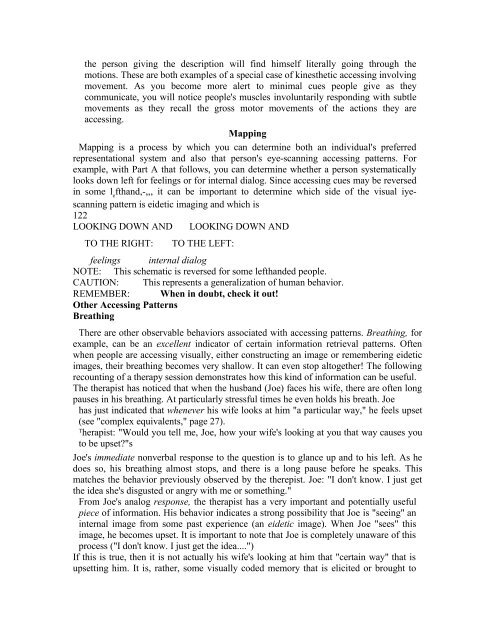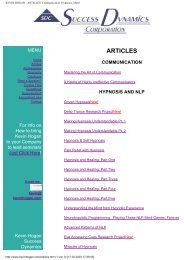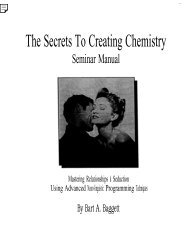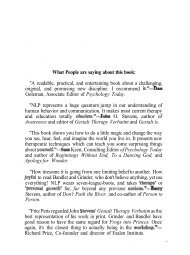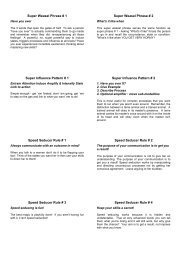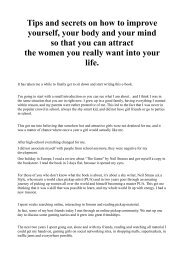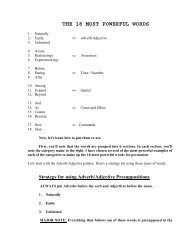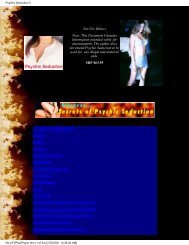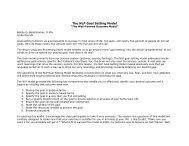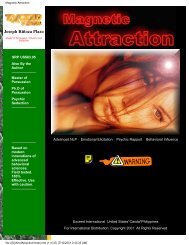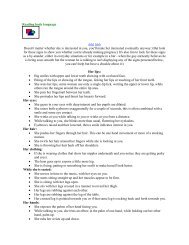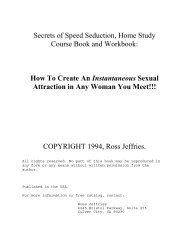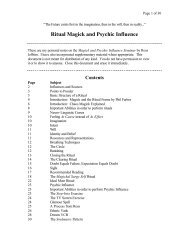A Pragmatic Guide To Communication & Change.pdf - NLP Info Centre
A Pragmatic Guide To Communication & Change.pdf - NLP Info Centre
A Pragmatic Guide To Communication & Change.pdf - NLP Info Centre
- No tags were found...
Create successful ePaper yourself
Turn your PDF publications into a flip-book with our unique Google optimized e-Paper software.
the person giving the description will find himself literally going through the<br />
motions. These are both examples of a special case of kinesthetic accessing involving<br />
movement. As you become more alert to minimal cues people give as they<br />
communicate, you will notice people's muscles involuntarily responding with subtle<br />
movements as they recall the gross motor movements of the actions they are<br />
accessing.<br />
Mapping<br />
Mapping is a process by which you can determine both an individual's preferred<br />
representational system and also that person's eye-scanning accessing patterns. For<br />
example, with Part A that follows, you can determine whether a person systematically<br />
looks down left for feelings or for internal dialog. Since accessing cues may be reversed<br />
in some l e<br />
fthand,-,,, it can be important to determine which side of the visual iyescanning<br />
pattern is eidetic imaging and which is<br />
122<br />
LOOKING DOWN AND LOOKING DOWN AND<br />
TO THE RIGHT:<br />
TO THE LEFT:<br />
feelings internal dialog<br />
NOTE: This schematic is reversed for some lefthanded people.<br />
CAUTION: This represents a generalization of human behavior.<br />
REMEMBER: When in doubt, check it out!<br />
Other Accessing Patterns<br />
Breathing<br />
There are other observable behaviors associated with accessing patterns. Breathing, for<br />
example, can be an excellent indicator of certain information retrieval patterns. Often<br />
when people are accessing visually, either constructing an image or remembering eidetic<br />
images, their breathing becomes very shallow. It can even stop altogether! The following<br />
recounting of a therapy session demonstrates how this kind of information can be useful.<br />
The therapist has noticed that when the husband (Joe) faces his wife, there are often long<br />
pauses in his breathing. At particularly stressful times he even holds his breath. Joe<br />
has just indicated that whenever his wife looks at him "a particular way," he feels upset<br />
(see "complex equivalents," page 27).<br />
T<br />
herapist: "Would you tell me, Joe, how your wife's looking at you that way causes you<br />
to be upset?"s<br />
Joe's immediate nonverbal response to the question is to glance up and to his left. As he<br />
does so, his breathing almost stops, and there is a long pause before he speaks. This<br />
matches the behavior previously observed by the therepist. Joe: "I don't know. I just get<br />
the idea she's disgusted or angry with me or something."<br />
From Joe's analog response, the therapist has a very important and potentially useful<br />
piece of information. His behavior indicates a strong possibility that Joe is "seeing" an<br />
internal image from some past experience (an eidetic image). When Joe "sees" this<br />
image, he becomes upset. It is important to note that Joe is completely unaware of this<br />
process ("I don't know. I just get the idea....")<br />
If this is true, then it is not actually his wife's looking at him that "certain way" that is<br />
upsetting him. It is, rather, some visually coded memory that is elicited or brought to


